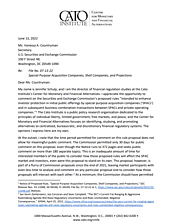At the outset, I note that the time period permitted for comment on this rule proposal does not allow for meaningful public comment. The Commission permitted only 30 days for public comment on this proposal, even though the Notice runs to 372 pages and seeks public comment on more than 180 separate topics. This is an inadequate amount of time for interested members of the public to consider how these proposed rules will affect the SPAC market and investors, even were this proposal to stand on its own. This proposal, however, is part of a flurry of Commission proposals since the end of 2021, leaving market participants with even less time to analyze and comment on any particular proposal and to consider how those proposals will interact with each other. At a minimum, the Commission should have permitted 60 days for public comment—the standard advised by long-standing Executive Order—but in light of the large number of outstanding rulemakings, a longer period of 90 days or more would have provided a more appropriate length of time for public comment.
Turning to the substance of the proposal, special purpose acquisition companies (SPACs) are companies formed specifically for the purpose of raising money to merge with an existing private company. The result is that the private operating company assumes the SPAC’s place as a listed public company. While not a new corporate form, SPACs rode an unprecedent wave of popularity in 2020 and 2021, outpacing the listings of traditional initial public offerings (IPOs). While this surge in SPAC popularity was likely the result of several factors, SPACs are viewed by some investors as a way to invest in younger, higher growth companies than those that typically access the markets through traditional IPOs. Some investors also view SPACs as providing easier access to newly listed companies than traditional IPOs, which typically allocate few shares to individual investors.


